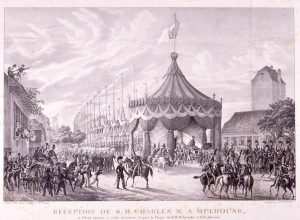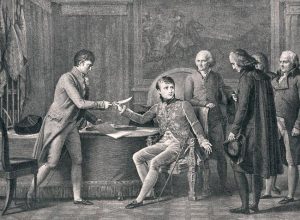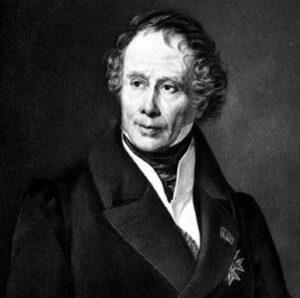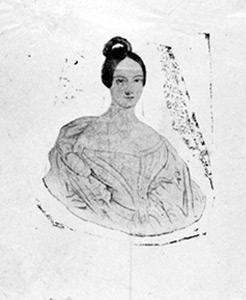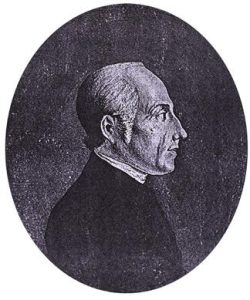The Consulate and the Empire
Alsace was tired of the uncertainties and excesses of the Directory and was enthusiastic about Napoleon Bonaparte. It celebrated each step of the new regime, especially its military odyssey, but was rather indifferent to the numerous administrative reforms. As other French regions did, it abandoned him after the campaign in Russia in 1812.
Among political and administrative measures, the Concordat and Organic Articles about Protestant worship were essential. Bonaparte, who saw the importance of the movement to revive religious traditions, was interested in strengthening the State, and negotiated a concordat with Pope Pius VII. The Concordat was signed on 15 July, 1801, and maintained one of the major acquisitions of the Revolution: Freedom of belief.
Bonaparte deemed fair to give a legal status to the Protestants too and to take their yearning into account. The Concordat was signed with the Catholic Church and completed with the Organic Articles – law of 8 April, 1802- awarding the Protestants a legal status. The law turned the parish into a constitutive cell of the Church. It allowed pastors and Councils of Churches to be elected by the parishioners, giving administrative responsibilities to the superior authorities alone.
The law voted by the legislative body and promulgated on 18 Germinal an X (8 April, 1802), however, did not quite meet the wishes of the Protestants. Indeed it eliminated the parish as a constitutive cell and replaced it with a consistory constituency with 6,000 parishioners. Each consistorial Church had a pastor supported by 6 to 12 notables among the wealthiest; five consistorial Churches together constituted a local synod district.
The creation of a national synod was refused to the Protestants. Bonaparte did not want a centralized body, but rather a plurality of consistories all over the country.
For the Lutherans an inspection body of the Augsburg Confession Church was created, an inspection (composed of one pastor and two laymen), oversaw five consistorial Churches.
Bonaparte however, in the interest of the State, wished to see the Protestants largely grouped in the Eastern part of the country form a block submitted to a centralized organization, namely a Directory founded in Strasbourg. Five of its members were appointed by the government who controlled it. The management was thus slightly controlled by the general Consistory in which each of the six inspections sent one of its members, and whose role was to choose two of the five members of the Directory.
As for the Catholics, all activities and nominations had to be approved by the local political power, in this case the prefects.
The law, even with its imperfections, was very welcomed. Services of thanksgiving were organized in every church; thus, Protestantism was considered on a par with Catholicism.
Particular attention was devoted to education. When the Organic Articles were discussed, the issue of pastors’ training was addressed. The Protestant University comprising a faculty of theology was in a turmoil. Bonaparte accepted the creation of an institution dedicated to theological teaching. Thus, the Organic Articles called for the creation of a seminary for the Lutherans as well as for the Reformed in Geneva, then French. Later on the seminary housed other subjects, pastor Oberlin for instance taught archaeology there.
Protestant secondary education was entrusted to the Gymnasium (Secondary School), which progressively alleviated its denominational character and competed with the Imperial High School. As for primary education it was entrusted to parishes.
In the early 19th century one third of the population in Alsace was Lutheran. There were many Lutherans in the old free cities such as Munster, Colmar, Wissembourg, and mainly Strasbourg where 25,000 inhabitants out of 38,000 were Protestant. Over 200 pastors served 160 Lutheran parishes.
In Mulhouse, exclusively Reformed, there were 14,000 worshippers among the 25,000 Reformed with 16 pastors.
The Alsatian society was noticeably became more French under the Empire, most apparently in cities. Theatre, Opera, French farce became popular. The official language in State establishments was French. Religious preachings were in both languages: French and German. The common language among peasants and workers was the Alsatian dialect, but thanks to school-teachers French progressively dominated.
The Restoration
During the Restoration the agreement between Catholics and Protestants was maintained. Article 5 in the Charter of Louis XVIII stated that ‘everyone professes their religion with equal freedom and receives the same protection for their worship.’ The only remaining conflicts concerned education which some Catholics wanted to control.
The Bonapartists, however, being more numerous in Alsace than elsewhere, were outraged by the counter-revolutionary measures decided by Charles X, especially about the alliance of the Throne and Altar, and started three-day long revolutionary rioting in July 1830. The revolt spread and on 12 August, Strasbourg proclaimed Louis-Philippe citizen-king.
The July Monarchy
Under the July Monarchy, Guizot ordered the creation of a primary school in every municipality, a decision in accordance with the Reformation which wanted a school beside every church. Thus, parish schools would become municipal schools and teachers would be on an equal footing with public teachers.
During the period when piety was revived, skirmishes with the Catholics resumed, sometimes taking on a derisory aspect, such as the controversy on Gutenberg’s celebration, or whether Luther’s effigy should be on an official memorial.
The Alsatian Protestants took as much part in the debates about rationalism, liberalism, revival, pietism, as Protestants in other regions.
The 2nd Republic
The Lutheran Directory had collapsed in the early days of the 1848 Revolution. A commission was set up who requested a new constitution of the Church. Reorganizing problems occupied a great place in the life of the Church. Advocates of the revolutionary ideal demanded that a confraternity be achieved in which all worshippers would take part in debating over the interests of the Church, the election of pastors and of lay administrators.
A constituent assembly was in charge of suggesting corrections to the Organic Articles deemed opposed to Protestantism. It asked that parishes and presbyteral councils be acknowledged, as well as the election of the Pastor.
For the Lutherans, after much debate, the general Consistory was expected to become the supreme authority, while the Directory oversaw current issues.
The ideas inspiring those suggestions were tempered by the government. In fact, the general Consistory was in charge of controlling the discipline, approving the rules about the interior regime, verifying books for religion teaching, checking the accounts. As for the Directory, it was in charge of appointing pastors, of administrative power, and of choosing the inspectors to be submitted to the government, as well as overseeing the Gymnasium (Secondary School) and the Seminary.
For the Protestants the 1852 decree extended the right to have a presbyteral council elected by all the parishioners in all parishes, the pastors being appointed by the Consistory.
The 1850 Falloux law confirmed the denominational nature of primary schools.
The Second Empire
Under the Second Empire the fundamental fact was a renewed attempt to question Protestant foundations, notably the property of the Lutheran Saint Thomas foundation to be allocated to the City of Strasbourg.
The French-Prussian war started in July 1870 and ended on 10 May, 1871. Alsace, except for the small Belfort region, was totally annexed by Prussia. Half of Lorraine with Metz and Thionville, suffered the same fate. One million inhabitants of Alsace and Lorraine over 14,500 square kilometers, became German. After an aborted attempt to introduce the Prussian ecclesiastical regime, the Organic Articles were maintained. A new episode in the history of Alsace was starting.

